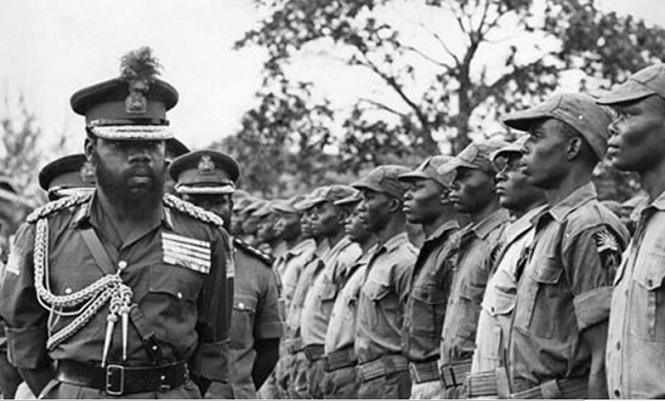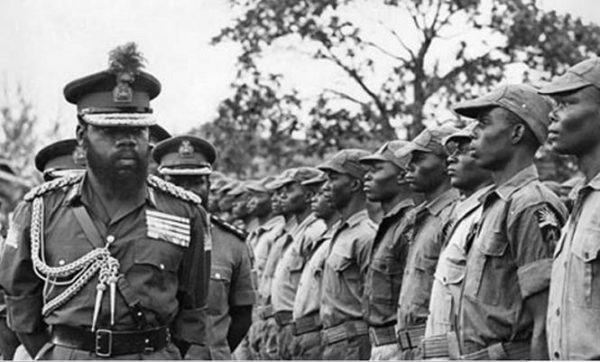The Midwest Invasion codenamed Operation Torch by the Biafran military forces happened between the 9th of August 1967 and 20th September 20, 1967. It was a military operation that saw the Biafran military forces seize portions of Nigeria’s territory in the old Midwest region.
Read more about Throwback Thursday
The march towards the Midwest from Eastern Region started with General Victor Banjo leading 3,000 Biafran soldiers to cross the Niger Bridge into Asaba.
Before the march towards the Midwest began, the Nigerian military council had decided and informed Midwest Governor, David Ejoor, in a military conference on June 7, after the Biafran declaration of independence that;
“Midwestern State will be kept free from active operations unless where necessary, but the border between the Eastern States and the Midwest will be completely sealed off.”
Ejoor also reiterated in a speech in Asaba that the Midwest would not be sucked into a war between the North and the East. The war was already being ethnicised even before it began and parties such as David Ejoor preferred not to play a part in that. Therefore, the grounds for the neutrality of the Midwest was already set and it was going to be a determining factor on where the fate of the Biafran war and the Midwest invasion swung.
Taking the town of Ore, however, marked a turning point in the invasion by the Biafran forces as it is a strategic town into the Southwestern part of the country. The invasion of the Midwest with the incursion into Ore became one of the major flashpoints of the entire Nigeria-Biafran War between 1967 and 1970.
Going a bit down memory lane – the coup d’état of January 1966 which saw a lot of non-Igbo personalities killed, and the subsequent Nigerian counter-coup in July 1966, which ended Major-General JTU Aguiyi-Ironsi, and a wave of resentment and reprisals against the Igbo ensued. This became one of the immediate causes of the Biafran secession and the subsequent war.
The constitutional conference of September 1966 did just a little to appease the sensibility of most of Nigeria’s regions as of then. Meanwhile, further negotiations about the fate of the nation held in Aburi and Benin led to an even greater misunderstanding and distrust between Col Chukwuemeka Ojukwu and the Nigerian Government, led by Yakubu Gowon. Biafra’s declaration of independence on May 30, 1967, was inevitable.
Sign up to the Connect Nigeria daily newsletter
David Ejoor’s choice of asking the federal government for weapons, and refusal to allow officers of Igbo origin in the Midwest from importing weapons, led to the government sending in just a small amount of Mark V rifles for the about 300 soldiers in the region. This was one of the reasons why any new mobilisation of troops within short notice could not be achieved by the Midwest and the state was left susceptible to the invasion.
Meanwhile, the decision by Odumegwu Ojukwu to invade the Midwest was born out of a need to distract the Nigerian forces after Nsukka fell to the Nigerian Army on July 14, 1967. The attempt to recapture Nsukka on July 30 failed and it resulted in the death of Major Kaduna Nzeogwu.
Ojukwu’s would later state the major reason Biafran forces invaded the Midwest:
“Our motive was not territorial ambition or the desire of conquest. We went into the Midwest purely in an effort to seize the serpent by the head; every other activity in that Republic was subordinated to that single aim. We were going to Lagos to seize the villain Gowon, and we took necessary military precautions.”
Also, the redeployment of Federal troops away from Okene around the time the invasion started worsened the preparedness of the Midwest as only about 300 troops were remaining in the entire MidWest military command.
By the night of August 8, Biafran boots landed in Asaba, and within minutes they had captured the post office and disconnected all major communication lines within the city. And by the morning of August 9, the logistics for the 3000 members mobilized rifle brigade of soldiers commanded by Victor Banjo to cross the Niger Bridge at Onitsha was already in motion.
As soon as the Biafrans military forces reached Agbor, they split up into newer units and battalions. The 18th Battalion swung south, occupying Sapele, Warri, and Ughelli, the 12th Battalion moved west to capture Benin City and Ore, while the 13th Battalion moved north to Agenebode, Auchi, and Okene.
In what became a shock to the Nigerian forces, the Biafrans had seized the entire Mid-Western Region in less than 12 hours with virtually very little resistance from the soldiers and people of the Midwest.
Source:
Wikipedia
Featured Image Source: Nairaland Forum
Got a suggestion? Contact us: [email protected]


